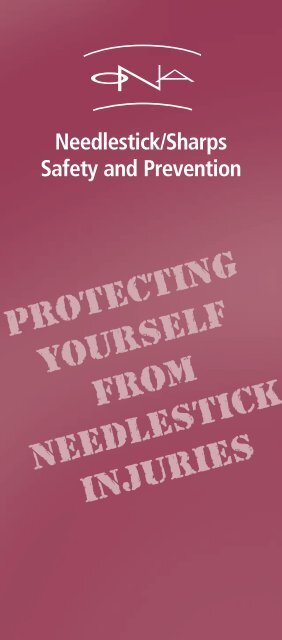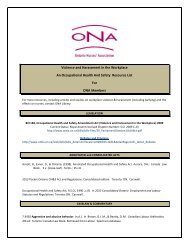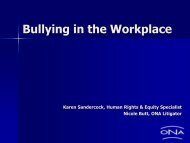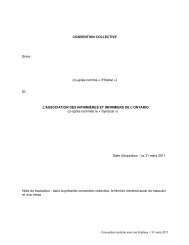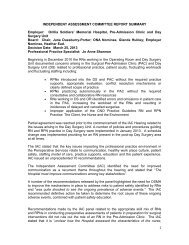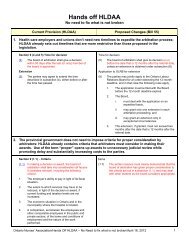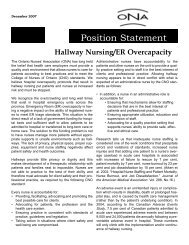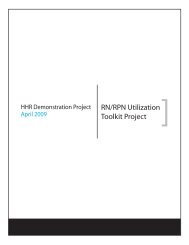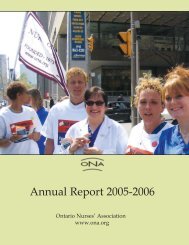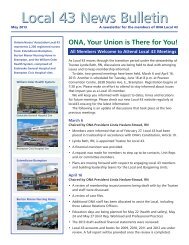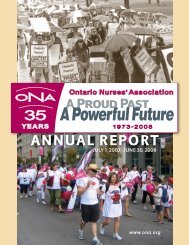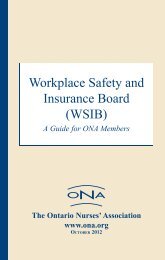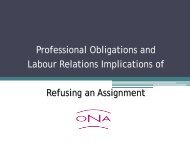Flyer: Needlestick/Sharps Safety and Prevention
Flyer: Needlestick/Sharps Safety and Prevention
Flyer: Needlestick/Sharps Safety and Prevention
- No tags were found...
Create successful ePaper yourself
Turn your PDF publications into a flip-book with our unique Google optimized e-Paper software.
<strong>Needlestick</strong>/<strong>Sharps</strong><strong>Safety</strong> <strong>and</strong> <strong>Prevention</strong>PROTECTINGYOURSELFFROMNEEDLESTICKINJURIES
PREVENTING SHARPS INJURIESWhile exposure to bloodborne pathogenspresents a deadly hazard, these risks are verypreventable. Over 80% of sharps injuries canbe prevented with the use of safety engineereddevices, which, in conjunction withworker training <strong>and</strong> work practice controls,can reduce injuries by over 90%.An effective sharps injury preventionprogram includes:• An assessment of hazards using theinstitution’s own, or the University ofVirginia EPINet data.• The implementation of safety engineereddevices with priority on vascularaccess <strong>and</strong> blood drawing devices.Next for consideration are hypodermicdevices, then blades, lancets, <strong>and</strong> lastlysutures.• A needlestick/sharps injury log containingthe situation <strong>and</strong> type of deviceinvolved in the incident, including make,model, <strong>and</strong> manufacturer.• A training program reviewed regularlyby the Joint Health & <strong>Safety</strong>Committee (JHSC) to provide workerswith information on the risks of bloodbornepathogens, <strong>and</strong> how to reducethese risks through safer products <strong>and</strong>practices. Workers should also betrained on post-exposure protocols.• An exposure control plan that bringsall of the above items together. Theexposure control plan is to be created<strong>and</strong> revised annually with input fromnon-managerial staff <strong>and</strong> the JHSC.
R I S K SEvery year ONA members working in health careare exposed to deadly bloodborne pathogens asa result of incidents from medical sharps devices.There are more than 69,000 sharps incidentseach year in this country. Although registerednurses sustain the majority of these injuries, doctors,lab technologists, housekeeping staff,maintenance workers, laundry workers <strong>and</strong>other health care workers also suffer needlestick<strong>and</strong> sharps injuries. These injuries are also acommunity health concern affecting waste disposalworkers, education sector workers, municipal,penal/penitentiary workers, etc. Eliminatingthese preventable hazards is a legitimate concernfor everyone at risk.RISK OF INJURYThe highest risk for pathogen transmission isfrom hollow-bore, blood-filled needles. Specificfeatures make some devices more dangerous:• Hollow-bore needles• Needle devices that must be taken apartor manipulated by the health care worker• Devices that retain an exposed needleafter use• Needles that are attached to tubingRISK OF DISEASE<strong>Sharps</strong> injuries can expose workers to a numberof bloodborne pathogens that can cause seriousor fatal infections. The bloodborne pathogensthat pose the greatest health risk are:•Hepatitis B virus (HBV)•Hepatitis C virus (HCV)•Human immunodeficiency virus (HIV)HBV vaccination has proved highly effective inpreventing infection. It is recommended for allhealth care workers. However, no vaccine existsto prevent HCV or HIV infection. Some risk factorscan increase the risk of HIV transmission.
WORK PRACTICESEngineering controls eliminate hazards at thesource <strong>and</strong> are the best <strong>and</strong> most effectiveapproach to occupational health <strong>and</strong> safety.<strong>Safety</strong> engineered needles <strong>and</strong> medical sharpsmust be the primary source of eliminating<strong>and</strong> reducing sharps related injuries.<strong>Safety</strong> engineered medical devices affordthe worker superior protection because thesafety features/technologies are designed<strong>and</strong> incorporated into the device.If you sustain an injury:• Wash the wound with soap<strong>and</strong> water• Alert your supervisor• Report immediately to employeehealth or emergency room (ER)• Ensure that you follow up the incidentwith your family physician• Get post-exposure prophylaxis withintwo hours of the exposure(if appropriate)• Document the incidentie. in a sharps injury log• Get follow-up testing <strong>and</strong> counselling• File a workers' compensation report• Notify your Joint Health & <strong>Safety</strong>Committee• Notify your BargainingUnit/Local/Labour Relations Officer
WHAT YOU SHOULD DO…• Insist on safety-engineered devicesin your workplace. Exercise yourlegal rights under the OccupationalHealth & <strong>Safety</strong> Act when necessary.• Always activate the safety featureof any device you are using.<strong>Safety</strong>-engineered devices eliminatethe unnecessary risk of recapping.• Plan for the safe h<strong>and</strong>ling <strong>and</strong> disposalof sharps before using them.• Promptly dispose of used sharps inappropriate sharps disposal containers.• Tell your supervisor, employer, <strong>and</strong>Joint Health & <strong>Safety</strong> Committeeabout any needlestick/sharps hazards.• Report all needlestick <strong>and</strong> sharpsrelatedinjuries promptly to ensureyou receive appropriate care.• Participate in training related toinfection prevention.• Get a hepatitis B vaccination.• Exercise your legal rights to health& safety protection, including theright to refuse unsafe work wherepossible. Please refer to ONA'swebsite for more information onyour Right to Refuse Unsafe Work.www.ona.org
HEAD OFFICE – TORONTO400 – 85 Grenville St., Toronto, ON. M5S 3A2Tel: (416) 964-8833 Toll-free: 1-800-387-5580Fax: (416) 964-8864Web site: www.ona.orgREGIONAL OFFICESHamiltonSudbury205 – 393 Rymal R. W. Unit 1, 760 Notre Dame Ave.Hamilton, ON. L9B 1V2 Sudbury, ON. P3A 2T3Tel: (905) 383-3341 Tel: (705) 560-2610Fax: (905) 574-0933 Fax: (705) 560-1411KingstonThunder Bay306 – 4 Cataraqui St. 214 Woodgate CentreKingston, ON. K7K 1Z7 1139 Alloy Dr.Tel: (613) 545-1110 Thunder Bay, ON. P7B 6M8Fax: (613) 531-9043 Tel: (807) 344-9115Fax: (807) 344-8850LondonTimmins204 – 750 Baseline Rd. E. 110A – 707 Ross Ave. E.London, ON. N6C 2R5 Timmins, ON. P4N 8R1Tel: (519) 438-2153 Tel: (705) 264-2294Fax: (519) 433-2050 Fax: (705) 268-4355OrilliaWindsor126A – 210 Memorial Ave. 220 – 3155 Howard Ave.Orillia, ON. L3V 7V1 Windsor, ON. N8X 3Y9Tel: (705) 327-0404 Tel: (519) 966-6350Fax: (705) 327-0511 Fax: (519) 972-0814Ottawa211 – 1400 Clyde Ave.,Nepean, ON. K2G 3J2Tel: (613) 226-3733Fax: (613) 723-0947


